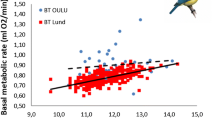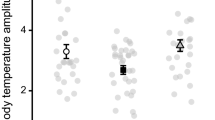Summary
In seasonal environments, time often constrains the timing and duration of processes in annual cycles of animals both on the diel and annual basis. Therefore, the allocation of time e.g. to foraging, resting and breeding behaviours should be true adaptations to the particular circumstances the animals experience.
In the present study, time budgets were established for two North Scandinavian starling (Sturnus vulgaris) populations (Andøya, Norway and Umeå, Sweden) with fundamentally different annual cycles. The major components of the time budgets of both populations were foraging and resting. There was also a pronounced seasonal shift in the relationship between these activities. As expected, starlings from both populations increased foraging time during the breeding period. However, contrary to the predictions foraging time was shortest in mid-winter for the sedentary northernmost population at Andøya. Moreover, females from both populations generally allocated more time to foraging than males.
These findings are discussed in relation to the energy maximizing-time minimizing concept. It is concluded that these foraging strategies are not as generally valid as previously assumed, especially not in highly seasonal environments.
Similar content being viewed by others
References
Altmann J (1974) Observational study of behavior: sampling methods. Behaviour 49:227–267
Brenner FJ (1964) Metabolism and survival time of grouped starlings at various temperatures. Wilson Bull 77:388–395
Brewer R (1963) Chimney perching for warmth in Starlings. Wilson Bull 76:447–449
Cody ML (1966) A general theory of clutch size. Evolution 20:174–184
Evans PR (1976) Energy balance and optimal foraging strategies in shorebirds: some implications for their distributions and movements in the non-breeding season. Ardea 64:117–139
Ettinger AD, King JR (1980) Time and energy budgets of the willow flycatcher (Empidonax traillii) during the breeding season. Auk 97:533–546
Feare C (1984) The starling. Oxford Univ Press, Oxford
Fliege G (1984) Das Zugverhalten des Stars (Sturnus vulgaris) in Europa: Eine Analyse der Ringfunde. J Orn 125:393–446
Gauthreaux SA Jr (1978) The ecological significance of behavioral dominance. In: PPG Bateson, PH Klopfer (eds) Perspectives in ethology, Vol 3. Plenum Publ Corp, pp 17–54
Gautreaux SA Jr (1983) The ecology and evolution of avian migration systems. In: DS Farner, JR King, KC Parkes (eds) Avian biology, Vol VI. Academic Press, New York, pp 93–168
Gibb JA (1956) Food, feeding habits, and territory of the rock pipit, Anthus spinoletta. Ibis 95:506–530
Herbers JM (1981) Time resources and laziness in animals. Oecologia (Berl) 49:252–262
Hickey TE, Titman RD (1983) Diurnal activity budgets of Black Ducks during their annual cycle in Prince Edward Island. Can J Zool 61:743–749
Hixon MA (1980) Food production and competitor density as the determinants of feeding territory size. Am Nat 115:510–530
Hixon MA (1982) Energy maximizers and time minimizers: theory and reality. Am Nat 119:596–599
King JR (1974) Seasonal allocation of time and energy resources in birds. In: RA Paynter Jr (ed) Avian energetics. Publ Nuttall Orn Club 15, Cambridge, Mass, pp 4–70
Krebs JR (1978) Optimal foraging: Decision rules for predators. In: JR Krebs, NB Davies (eds) Behavioural ecology: an evolutionary approach. Blackwells, Oxford, pp 23–63
Lack D (1968) Ecological adaptations for breeding in birds. Methuen
Lundberg P, Eriksson L-O (1984) Postjuvenile moult in two north Scandinavian Starling Sturnus vulgaris populations-evidence for difference in the circannual time program. Ornis Scand 15:105–109
Lundberg P, Silverin B (1985) Breeding cycles in two north Scandinavian Starling Sturnus vulgaris populations and the circannual testicular and gonadotrophin cycles. Ornis Scand 16:in press
Maxon SJ, Oring LW (1980) Breeding season time and energy budgets of the polyandrous spotted sandpiper. Behaviour 74:200–262
Murton RK, Westwood NJ (1977) Avian breeding cycles. Clarendon Press, Oxford
Norberg RÅ (1977) An ecological theory on foraging time and energetics and choice of optimal food-searching method. J Anim Ecol 46:511–529
Parker GA (1974) Courtship persistence and female-guarding as male time investment strategies. Behaviour 48:157–184
Perrins CM, Birkhead TR (1983) Avian ecology. Blackie, Glasgow
Pianka ER (1976) Natural selection of optimal reproductive tactics. Am Zool 16:775–784
Pyke GH, Pulliam HR, Charnov EL (1977) Optimal foraging: a selective review of theory and tests. Q Rev Biol 52:137–154
Ricklefs RE (1983) Comparative avian demography. In: RF Johnston (ed) Current ornithology, Vol I. Plenum Press, New York, pp 1–32
Schoener TW (1971) Theory of feeding strategies. Ann Rev Ecol Syst 2:369–404
Siegfried WR, Burger AE, Frost PHG (1976) Energy requirements for breeding in the maccoa duck. Ardea 64:171–191
Sokal RR, Rohlf FJ (1973) Introduction to biostatistics. Freeman, San Fransisco
Tyler S (1979) Time-sampling: a matter of convention. Anim Behav 27:801–810
Verbeek NAM (1972) Daily and annual time budget of the yellowbilled magpie. Auk 89:567–582
Wagner G (1958) Verbreitung und Überwinterung des Stars (Sturnus vulgaris) nördlich des Polarkreises in Norwegen. Sterna 3:73–89
Walsberg GE (1980) Energy expenditure in free-living birds: patterns and diversity. Proc XVII Int Orn Congr, Berlin, 300–305
Author information
Authors and Affiliations
Rights and permissions
About this article
Cite this article
Lundberg, P. Time-budgeting by starlings Sturnus vulgaris: Time minimizing, energy maximizing and the annual cycle organization. Oecologia 67, 331–337 (1985). https://doi.org/10.1007/BF00384937
Received:
Issue Date:
DOI: https://doi.org/10.1007/BF00384937




